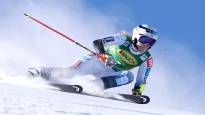The fluoride ban, which has caused a stir in recent years by the International Ski Federation FIS, was used for the first time on Saturday, when the alpine women opened the giant slalom World Cup season in Sölden, Austria.
Right in the opening round, you got the hang of it. Off the track though.
The jury rejected the Norwegian accountant by Ragnhild Mowinckelbecause the device designed to monitor the fluoride ban showed that Mowinckel’s skis contained prohibited fluoride above the permitted limit value.
Mowinckel assured in an interview with TV2 his innocence.
– Of course, we’re not trying to cheat. That’s the worst I know.
– I think there have been fluoride residues in the equipment. This should not happen at the Games. We’ll figure it out.
The jury had said, according to Mowinckel, that the amount of fluoride in the skis is so high that it could not have entered them from the slope. Mowinckel’s situation is not surprising when you take into account the information that has come out in recent years and months about the device designed to monitor the fluoride ban.
The ban has been postponed several times
FIS already announced in 2019 that the fluoride ban will be introduced in the 2020–2021 season. Since then, the association has repeatedly postponed the ban by up to a year because it has not been able to develop a reliable monitoring mechanism for the ban.
FIS has not revealed exactly how the device it ordered from the US manufacturer works. Athletes, coaches as well as equipment and ointment manufacturers have criticized the association’s activities in strong terms.
The latest expression of opinion was revealed a week ago, when Urheilu got hold of a petition signed by alpine skiers. In it, the alpine skiers asked the FIS management to postpone the ban, which they otherwise welcomed, but which, with its unreliable supervision, would cause significant problems for the sport.
The petition addressed to the FIS management was signed by the 30 best male and female calculators of the World Cup.
The plea did not fall on deaf ears. On Wednesday, FIS announced that it will raise its rejection threshold from 1 to 1.8.
On Thursday, Urheilu interviewed an impressive figure in the maintenance of the Finnish national cross-country skiing team Teemu Lemmettyläwho has been involved a lot with the equipment that monitors the fluoride test.
According to Lemmettylä, the reasons for raising the limit value were clear.
– With this, FIS aims to prevent the so-called “false positive” fluoride tests, Lemmettylä said on Thursday.
What the numbers mean is still a mystery to those in the sport.
– You can write 1.0, or put a percentage or whatever after. It is not defined what the number means, it is just the value given by the device. The device manufacturer talks about the fluoride percentage, but you don’t have to go very far when you can state that it doesn’t mean that, because the device can go into the red, Lemmettylä said.
According to Lemmettylä, the device illuminates the sole of the ski with infrared, the reflection of which is converted into a frequency.
– If you measure twice from the same point, you will never get the same number. That number one is a little strict as a limit value, which is why a little space has been given to be able to avoid false positives, Lemmettylä said.
However, Lemmettylä was able to give an illustrative example of what kind of results we are talking about when ski soles are treated with fluorine lubrication, which has been normal until now.
– Low-fluorine lubrication gives a reading that is on the surface of three. The high-fluorine wax is eight and seven on both sides. Normal fluorine pulverization means a reading of 20 on both sides.
Fluoride-free also give positives
Ointment maker Jari Joutsen spent last weekend with the Finnish and Austrian national ski team in Vuokatti, testing the device that monitors the fluoride ban.
In terms of Mowinckel’s case, it is essential that Joutsen found that the monitoring device also gave positive results for fluorine-free creams.
– I have proof from my raw material manufacturer that it is a completely fluorine-free substance. Still, the control gave my cream a fluoride reading of 7-9. Another cream manufacturer got an even higher reading with its own fluoride-free cream, 19.
– The problem has been the same for several cream manufacturers, Joutsen said on Thursday.
In recent years, Joutsen has been actively in contact with the FIS management in order to get clarity on how to conduct his business within the limits of the federation’s rules. All of Joutenne’s products – both fluorine-free and fluorine-containing – comply with legal requirements, even though the FIS wants to ban fluorine.
Joutsen says that he found out from FIS that the algorithm of the device presented this year is constantly being updated to avoid false positive results. Joutsen has not received a more detailed explanation from FIS as to why the device gives a false positive result, let alone other information about the operating logic.
– When I develop new products, it seems that all the raw materials must first be used in this monitoring device. It’s special when you are competing and teaching the device that is used to monitor the races at the same time.
– This is nothing but the ingredients of a disaster, says Joutsen.
